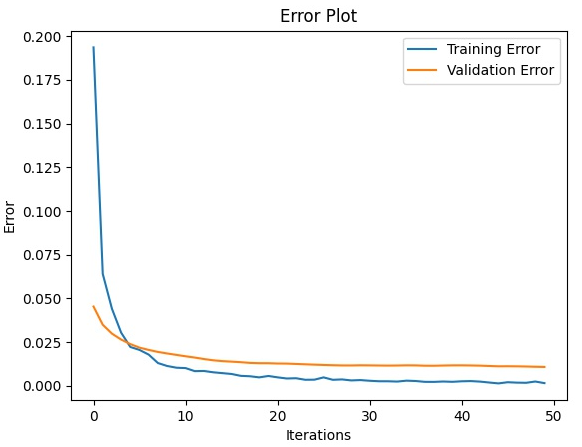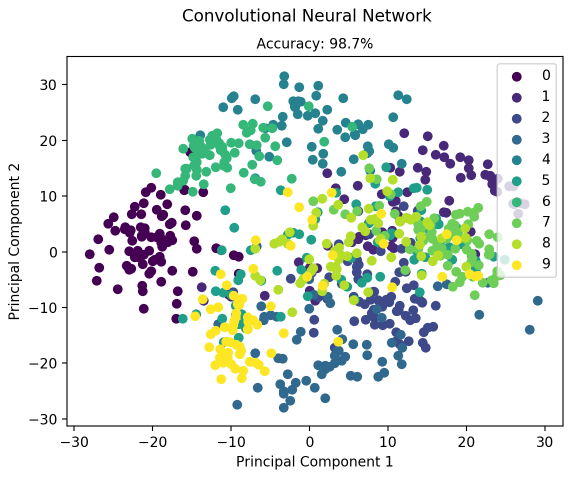代码来源:https://github.com/eriklindernoren/ML-From-Scratch
卷积神经网络中卷积层Conv2D(带stride、padding)的具体实现:https://www.cnblogs.com/xiximayou/p/12706576.html
激活函数的实现(sigmoid、softmax、tanh、relu、leakyrelu、elu、selu、softplus):https://www.cnblogs.com/xiximayou/p/12713081.html
损失函数定义(均方误差、交叉熵损失):https://www.cnblogs.com/xiximayou/p/12713198.html
优化器的实现(SGD、Nesterov、Adagrad、Adadelta、RMSprop、Adam):https://www.cnblogs.com/xiximayou/p/12713594.html
卷积层反向传播过程:https://www.cnblogs.com/xiximayou/p/12713930.html
全连接层实现:https://www.cnblogs.com/xiximayou/p/12720017.html
批量归一化层实现:https://www.cnblogs.com/xiximayou/p/12720211.html
池化层实现:https://www.cnblogs.com/xiximayou/p/12720324.html
padding2D实现:https://www.cnblogs.com/xiximayou/p/12720454.html
Flatten层实现:https://www.cnblogs.com/xiximayou/p/12720518.html
上采样层UpSampling2D实现:https://www.cnblogs.com/xiximayou/p/12720558.html
Dropout层实现:https://www.cnblogs.com/xiximayou/p/12720589.html
激活层实现:https://www.cnblogs.com/xiximayou/p/12720622.html
定义训练和测试过程:https://www.cnblogs.com/xiximayou/p/12725873.html
代码在mlfromscratch/examples/convolutional_neural_network.py 中:
from __future__ import print_function from sklearn import datasets import matplotlib.pyplot as plt import math import numpy as np # Import helper functions from mlfromscratch.deep_learning import NeuralNetwork from mlfromscratch.utils import train_test_split, to_categorical, normalize from mlfromscratch.utils import get_random_subsets, shuffle_data, Plot from mlfromscratch.utils.data_operation import accuracy_score from mlfromscratch.deep_learning.optimizers import StochasticGradientDescent, Adam, RMSprop, Adagrad, Adadelta from mlfromscratch.deep_learning.loss_functions import CrossEntropy from mlfromscratch.utils.misc import bar_widgets from mlfromscratch.deep_learning.layers import Dense, Dropout, Conv2D, Flatten, Activation, MaxPooling2D from mlfromscratch.deep_learning.layers import AveragePooling2D, ZeroPadding2D, BatchNormalization, RNN def main(): #---------- # Conv Net #---------- optimizer = Adam() data = datasets.load_digits() X = data.data y = data.target # Convert to one-hot encoding y = to_categorical(y.astype("int")) X_train, X_test, y_train, y_test = train_test_split(X, y, test_size=0.4, seed=1) # Reshape X to (n_samples, channels, height, width) X_train = X_train.reshape((-1,1,8,8)) X_test = X_test.reshape((-1,1,8,8)) clf = NeuralNetwork(optimizer=optimizer, loss=CrossEntropy, validation_data=(X_test, y_test)) clf.add(Conv2D(n_filters=16, filter_shape=(3,3), stride=1, input_shape=(1,8,8), padding='same')) clf.add(Activation('relu')) clf.add(Dropout(0.25)) clf.add(BatchNormalization()) clf.add(Conv2D(n_filters=32, filter_shape=(3,3), stride=1, padding='same')) clf.add(Activation('relu')) clf.add(Dropout(0.25)) clf.add(BatchNormalization()) clf.add(Flatten()) clf.add(Dense(256)) clf.add(Activation('relu')) clf.add(Dropout(0.4)) clf.add(BatchNormalization()) clf.add(Dense(10)) clf.add(Activation('softmax')) print () clf.summary(name="ConvNet") train_err, val_err = clf.fit(X_train, y_train, n_epochs=50, batch_size=256) # Training and validation error plot n = len(train_err) training, = plt.plot(range(n), train_err, label="Training Error") validation, = plt.plot(range(n), val_err, label="Validation Error") plt.legend(handles=[training, validation]) plt.title("Error Plot") plt.ylabel('Error') plt.xlabel('Iterations') plt.show() _, accuracy = clf.test_on_batch(X_test, y_test) print ("Accuracy:", accuracy) y_pred = np.argmax(clf.predict(X_test), axis=1) X_test = X_test.reshape(-1, 8*8) # Reduce dimension to 2D using PCA and plot the results Plot().plot_in_2d(X_test, y_pred, title="Convolutional Neural Network", accuracy=accuracy, legend_labels=range(10)) if __name__ == "__main__": main()
我们还是一步步进行分析:
1、优化器使用Adam()
2、数据集使用的是sklearn.datasets中的手写数字,其部分数据如下:
(1797, 64) (1797,) [[ 0. 0. 5. 13. 9. 1. 0. 0. 0. 0. 13. 15. 10. 15. 5. 0. 0. 3. 15. 2. 0. 11. 8. 0. 0. 4. 12. 0. 0. 8. 8. 0. 0. 5. 8. 0. 0. 9. 8. 0. 0. 4. 11. 0. 1. 12. 7. 0. 0. 2. 14. 5. 10. 12. 0. 0. 0. 0. 6. 13. 10. 0. 0. 0.] [ 0. 0. 0. 12. 13. 5. 0. 0. 0. 0. 0. 11. 16. 9. 0. 0. 0. 0. 3. 15. 16. 6. 0. 0. 0. 7. 15. 16. 16. 2. 0. 0. 0. 0. 1. 16. 16. 3. 0. 0. 0. 0. 1. 16. 16. 6. 0. 0. 0. 0. 1. 16. 16. 6. 0. 0. 0. 0. 0. 11. 16. 10. 0. 0.] [ 0. 0. 0. 4. 15. 12. 0. 0. 0. 0. 3. 16. 15. 14. 0. 0. 0. 0. 8. 13. 8. 16. 0. 0. 0. 0. 1. 6. 15. 11. 0. 0. 0. 1. 8. 13. 15. 1. 0. 0. 0. 9. 16. 16. 5. 0. 0. 0. 0. 3. 13. 16. 16. 11. 5. 0. 0. 0. 0. 3. 11. 16. 9. 0.] [ 0. 0. 7. 15. 13. 1. 0. 0. 0. 8. 13. 6. 15. 4. 0. 0. 0. 2. 1. 13. 13. 0. 0. 0. 0. 0. 2. 15. 11. 1. 0. 0. 0. 0. 0. 1. 12. 12. 1. 0. 0. 0. 0. 0. 1. 10. 8. 0. 0. 0. 8. 4. 5. 14. 9. 0. 0. 0. 7. 13. 13. 9. 0. 0.] [ 0. 0. 0. 1. 11. 0. 0. 0. 0. 0. 0. 7. 8. 0. 0. 0. 0. 0. 1. 13. 6. 2. 2. 0. 0. 0. 7. 15. 0. 9. 8. 0. 0. 5. 16. 10. 0. 16. 6. 0. 0. 4. 15. 16. 13. 16. 1. 0. 0. 0. 0. 3. 15. 10. 0. 0. 0. 0. 0. 2. 16. 4. 0. 0.] [ 0. 0. 12. 10. 0. 0. 0. 0. 0. 0. 14. 16. 16. 14. 0. 0. 0. 0. 13. 16. 15. 10. 1. 0. 0. 0. 11. 16. 16. 7. 0. 0. 0. 0. 0. 4. 7. 16. 7. 0. 0. 0. 0. 0. 4. 16. 9. 0. 0. 0. 5. 4. 12. 16. 4. 0. 0. 0. 9. 16. 16. 10. 0. 0.] [ 0. 0. 0. 12. 13. 0. 0. 0. 0. 0. 5. 16. 8. 0. 0. 0. 0. 0. 13. 16. 3. 0. 0. 0. 0. 0. 14. 13. 0. 0. 0. 0. 0. 0. 15. 12. 7. 2. 0. 0. 0. 0. 13. 16. 13. 16. 3. 0. 0. 0. 7. 16. 11. 15. 8. 0. 0. 0. 1. 9. 15. 11. 3. 0.] [ 0. 0. 7. 8. 13. 16. 15. 1. 0. 0. 7. 7. 4. 11. 12. 0. 0. 0. 0. 0. 8. 13. 1. 0. 0. 4. 8. 8. 15. 15. 6. 0. 0. 2. 11. 15. 15. 4. 0. 0. 0. 0. 0. 16. 5. 0. 0. 0. 0. 0. 9. 15. 1. 0. 0. 0. 0. 0. 13. 5. 0. 0. 0. 0.] [ 0. 0. 9. 14. 8. 1. 0. 0. 0. 0. 12. 14. 14. 12. 0. 0. 0. 0. 9. 10. 0. 15. 4. 0. 0. 0. 3. 16. 12. 14. 2. 0. 0. 0. 4. 16. 16. 2. 0. 0. 0. 3. 16. 8. 10. 13. 2. 0. 0. 1. 15. 1. 3. 16. 8. 0. 0. 0. 11. 16. 15. 11. 1. 0.] [ 0. 0. 11. 12. 0. 0. 0. 0. 0. 2. 16. 16. 16. 13. 0. 0. 0. 3. 16. 12. 10. 14. 0. 0. 0. 1. 16. 1. 12. 15. 0. 0. 0. 0. 13. 16. 9. 15. 2. 0. 0. 0. 0. 3. 0. 9. 11. 0. 0. 0. 0. 0. 9. 15. 4. 0. 0. 0. 9. 12. 13. 3. 0. 0.]] [0 1 2 3 4 5 6 7 8 9]
3、接着有一个to_categorical()函数,在mlfromscratch.utils下的data_manipulation.py中:
def to_categorical(x, n_col=None): """ One-hot encoding of nominal values """ if not n_col: n_col = np.amax(x) + 1 one_hot = np.zeros((x.shape[0], n_col)) one_hot[np.arange(x.shape[0]), x] = 1 return one_hot
用于将标签转换为one-hot编码。
4、划分训练集和测试集:train_test_split(),在mlfromscratch.utils下的data_manipulation.py中:
def train_test_split(X, y, test_size=0.5, shuffle=True, seed=None): """ Split the data into train and test sets """ if shuffle: X, y = shuffle_data(X, y, seed) # Split the training data from test data in the ratio specified in # test_size split_i = len(y) - int(len(y) // (1 / test_size)) X_train, X_test = X[:split_i], X[split_i:] y_train, y_test = y[:split_i], y[split_i:] return X_train, X_test, y_train, y_test
5、由于卷积神经网络的输入是[batchsize,channel,wheight,width]的维度,因此要将原始数据进行转换,即将(1797,64)转换为(1797,1,8,8)格式的数据。这里batchsize就是样本的数量。
6、定义卷积神经网络的训练和测试过程:包括优化器、损失函数、测试数据
7、定义模型结构
8、输出模型每层的类型、参数数量以及输出大小
9、将数据输入到模型中,设置epochs的大小以及batch_size的大小
10、计算训练和测试的错误,并绘制成图
11、计算准确率
12、绘制测试集中每一类预测的结果,这里有一个plot_in_2d()函数,位于mlfromscratch.utils下的misc.py中
# Plot the dataset X and the corresponding labels y in 2D using PCA. def plot_in_2d(self, X, y=None, title=None, accuracy=None, legend_labels=None): X_transformed = self._transform(X, dim=2) x1 = X_transformed[:, 0] x2 = X_transformed[:, 1] class_distr = [] y = np.array(y).astype(int) colors = [self.cmap(i) for i in np.linspace(0, 1, len(np.unique(y)))] # Plot the different class distributions for i, l in enumerate(np.unique(y)): _x1 = x1[y == l] _x2 = x2[y == l] _y = y[y == l] class_distr.append(plt.scatter(_x1, _x2, color=colors[i])) # Plot legend if not legend_labels is None: plt.legend(class_distr, legend_labels, loc=1) # Plot title if title: if accuracy: perc = 100 * accuracy plt.suptitle(title) plt.title("Accuracy: %.1f%%" % perc, fontsize=10) else: plt.title(title) # Axis labels plt.xlabel('Principal Component 1') plt.ylabel('Principal Component 2') plt.show()
接下来就可以实际进行操作了,我是在谷歌colab中,首先使用:
!git clone https://github.com/eriklindernoren/ML-From-Scratch.git
将相关代码复制下来。
然后进行安装:在ML-From-Scratch目录下输入:
!python setup.py install
最后输入:
!python mlfromscratch/examples/convolutional_neural_network.py
最终结果:
+---------+ | ConvNet | +---------+ Input Shape: (1, 8, 8) +----------------------+------------+--------------+ | Layer Type | Parameters | Output Shape | +----------------------+------------+--------------+ | Conv2D | 160 | (16, 8, 8) | | Activation (ReLU) | 0 | (16, 8, 8) | | Dropout | 0 | (16, 8, 8) | | BatchNormalization | 2048 | (16, 8, 8) | | Conv2D | 4640 | (32, 8, 8) | | Activation (ReLU) | 0 | (32, 8, 8) | | Dropout | 0 | (32, 8, 8) | | BatchNormalization | 4096 | (32, 8, 8) | | Flatten | 0 | (2048,) | | Dense | 524544 | (256,) | | Activation (ReLU) | 0 | (256,) | | Dropout | 0 | (256,) | | BatchNormalization | 512 | (256,) | | Dense | 2570 | (10,) | | Activation (Softmax) | 0 | (10,) | +----------------------+------------+--------------+ Total Parameters: 538570 Training: 100% [------------------------------------------------] Time: 0:01:32 <Figure size 640x480 with 1 Axes> Accuracy: 0.9846796657381616 <Figure size 640x480 with 1 Axes>


至此,结合代码一步一步看卷积神经网络的整个实现过程就完成了。通过结合代码的形式,可以加深对深度学习中卷积神经网络相关知识的理解。